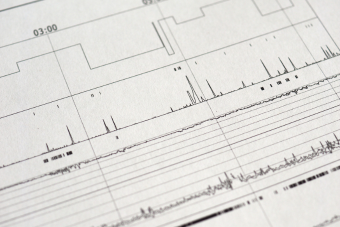
Sleep Polysomnography
Index

It is common knowledge that sleep is an essential physiological state for the health and well-being of our body. During sleep, our body performs several important functions, such as regulating the immune system and consolidating memory.
However, the sleep disorders continue to affect the quality and quantity of sleep, compromising the health and quality of life of those who suffer from them. If you are (or have already been) experiencing a sleep disorder, you certainly know the influence they can have on your day-to-day life!
Sleep disorders affect a large number of people around the world. According to a recent study carried out by the Portuguese Sleep Association in conjunction with CINEICC, released by Expresso Newspaper, nearly 20% of Portuguese people suffer from chronic insomnia, having difficulty falling or staying asleep for at least three nights a week.
These disorders include insomnia, sleep apnea, sleepwalking, bruxism, among others. Caused by factors such as stress, anxiety, depression, respiratory problems and/or neurological diseases, sleep disorders can have a significant impact on our quality of life. For those who sleep with others, it is an even greater problem!
To assess sleep quality and diagnose potential associated disorders, it is important to monitor sleep.
The importance of sleep monitoring
The sleep monitoring process involves evaluating and recording the different phases of our sleep, as well as other important related aspects such as heart rate, body movements and breathing patterns.
Sleep trackers most well-known and used ones appear in digital format - through some free cell phone applications - and allow us to track our sleep while we sleep. Although sleep monitoring through these trackers can be very useful for evaluating basic levels of sleep patterns, it is important to remember that they may not present 100% faithful and accurate results in measuring the parameters under evaluation.
Therefore, the best way to monitor and evaluate sleep is through an exam called Polysomnography which is nothing more or less than a sleep exam.
Sleep polysomnography
Sleep polysomnography is an exam that allows the assessment of sleep quality and disorders that may be related.
During this sleep examination, several physiological parameters are monitored and recorded, including brain activity, eye movements, muscle activity, heart rate, blood oxygenation and breathing.
In addition to being an exam that allows us to evaluate our sleep in general, it is mainly indicated and used for diagnosis of sleep disorders, such as obstructive sleep apnea, insomnia, sleepwalking, among others.
Polysomnography is considered a “golden test” when it comes to diagnosing sleep disorders, as it provides detailed information about the different phases of sleep and the physiological changes that occur during sleep.
Who should have a polysomnography?
Sleep polysomnography is mostly indicated for patients who suffer from some type of sleep disorder. Between them:
- Obstructive sleep apnea;
- Excessive snoring;
- Bruxism;
- Insomnia;
- Excessive drowsiness;
- Sleep-walking;
- Restless legs syndrome;
- Arrhythmias that occur during sleep;
- Night terrors;
The polysomnography exam is a safe and non-invasive procedure that can help improve the quality of life of people with sleep disorders, but not only that.
In addition to diagnosing sleep disorders, polysomnography can also be used to evaluate the effectiveness of any treatment that is already being carried out due to a previously diagnosed sleep disorder. For example, after starting treatment for sleep apnea, it is possible to perform a new polysomnography to check whether there has been a reduction in the number of apnea events during sleep.
On the other hand, sleep polysomnography can also be very useful to evaluate the sleep quality in some specific situations or patients, such as elderly people or patients with neurological diseases. In addition to evaluating any sleep changes that may exist, this sleep examination can help prescribe specific treatments to improve the quality of rest for these people.
How does polysomnography work? What is evaluated?
During the exam, the patient is monitored while sleeping in a comfortable and quiet environment. The room is equipped with a video camera to capture movements and behaviors during sleep, as well as an audio system to allow monitoring of any sounds - which also allows communication between patients and technicians if necessary.
The patient is connected to a series of sensors responsible for monitoring brain activity, breathing, heart rate, eye movements and other indicators related to sleep.

Infographic: Colmol
During the sleep examination, the information collected by the sensors is recorded on a computer for later analysis by a qualified healthcare professional.
Assessments are made of several factors, including:
- Brain waves;
- Eye movement;
- Heart rate;
- Breathing rate;
- Blood oxygen level;
- Body positioning;
- Movement of limbs;
- Sounds produced during sleep.
Where is sleep polysomnography performed?
This sleep test lasts for a normal night's rest - from the moment we go to bed until the moment we wake up - and can be done in hospitals or clinics specialized services, as long as they have the necessary conditions to carry out
In some cases, it is also possible to carry out home polysomnography through a portable device that is given to the patient. Although it is not as complete as the exam carried out in a hospital or clinic, home polysomnography can be useful in some situations, as long as it is recommended by a doctor.
The type of examination to be performed (hospital/clinic polysomnography or home polysomnography) is defined based on the clinical criteria related to the suspected sleep disorder that may exist.
I will perform a sleep polysomnography. What preliminary precautions should be taken?
According to official guidelines from the SNS24, there are some precautions to be taken on the day the sleep polysomnography is performed. The following are recommended:
- Do not take naps;
- Avoid the consumption of alcohol, coffee and stimulant drinks;
- Maintain the use of usual medications;
- Avoid using creams, shampoos and conditioners that affect the adhesion of the exam sensors to the body;
- Do not use gel or gel nails;
Furthermore, for people under 18 years of age, with disabilities and/or elderly people with limitations, the presence of companions is mandatory.
What are the warning signs that indicate sleep disorders? Your body responds!

Many of the signs that indicate the possibility of sleep disorders manifest themselves during the time we spend sleeping, and can even be easily identified by our partners. However, there are some symptoms that can also appear during the day and even go unnoticed or neglected.
It is important to keep in mind that the presence of some symptoms - both during the day and at night - may already indicate the presence of a significant sleep disorder problem. These warning signs should be evaluated by a healthcare professional, who may advise carrying out a sleep test such as polysomnography or another type of differentiated treatment.
Common symptoms of sleep disorders.
During the day:
- Excessive drowsiness;
- Fatigue;
- Difficulties in concentrating;
- Mood changes;
- Morning headaches;
At night:
- Snore;
- Breathing pauses;
- Abnormal motor activity;
- Dry mouth;
- Nocturia (greater urge to urinate at night);
- Feeling nervous;
- Feeling of suffocation;
- Family history of snoring and/or sleep apnea.
Regarding the symptoms that may appear during the night, most of the time, they are only identifiable by the partner or through a sleep test.
6 healthy habits that can help prevent sleep disorders
Fortunately, there are several ways to prevent sleep disorders. Find out how you can avoid them, so you can enjoy a peaceful, restful night's sleep.
- Maintain a regular sleep schedule: try to sleep and wake up at the same time every day, including weekends;
- Create a peaceful sleeping environment: make sure your room is dark, quiet and cool. Consider using curtains blackout, earplugs or white noise to help block outside sounds.
- Avoid caffeine and alcohol before bed: These types of drinks can negatively interfere with your sleep.
- Practice a relaxing routine before bed: Try to do relaxing activities before bed, such as reading a book, to meditate or take a hot shower. Avoid using electronic devices before bed, as the blue light emitted by them screens can affect sleep.
- Exercise regularly: Regular exercise can help improve sleep quality, and there are certain exercises that can be done before bed so you can rest better.
- Manage stress: Adopt stress management practices, such as yoga, meditation or breathing techniques.
Still, it's important to remember that, if you have chronic sleep problems, it's always best to consult a doctor! In addition to helping you identify the underlying cause of your sleep disorders, it can prescribe the appropriate treatment for your needs.
—
At Colmol, our priority is the satisfaction of those looking to improve their night's rest through effective and quality products. Our team of Sleep Specialists. We provide personalized advice on a daily basis, adapted to the needs of each client who comes to us.
If you are looking for this specialized help, you can contact us directly at::
- telephone the number +351 300 600 110
- or send us your questions to suporte@colmol.pt
We are always available to help you… and your sleep 🧡
